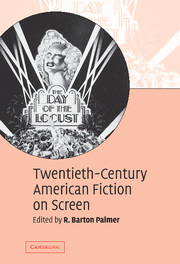Book contents
- Frontmatter
- Contents
- List of illustrations
- Notes on contributors
- Acknowledgments
- Introduction
- 1 Filming an unfinished novel: The Last Tycoon
- 2 The texts behind The Killers
- 3 The Day of the Locust: 1939 and 1975
- 4 Ship of Fools: from novel to film
- 5 Intruder in the Dust and the southern community
- 6 Dramatizing The Member of the Wedding
- 7 Film and narration: two versions of Lolita
- 8 World War II through the lens of Vietnam: adapting Slaughterhouse-Five to film
- 9 John Huston's Wise Blood
- 10 Genre and authorship in David Cronenberg's Naked Lunch
- 11 Screening Raymond Carver: Robert Altman's Short Cuts
- 12 The Color Purple: translating the African-American novel for Hollywood
- 13 The specter of history: filming memory in Beloved
- 14 Filming the spiritual landscape of James Jones's The Thin Red Line
- Filmography
- Index
- References
13 - The specter of history: filming memory in Beloved
Published online by Cambridge University Press: 12 January 2010
- Frontmatter
- Contents
- List of illustrations
- Notes on contributors
- Acknowledgments
- Introduction
- 1 Filming an unfinished novel: The Last Tycoon
- 2 The texts behind The Killers
- 3 The Day of the Locust: 1939 and 1975
- 4 Ship of Fools: from novel to film
- 5 Intruder in the Dust and the southern community
- 6 Dramatizing The Member of the Wedding
- 7 Film and narration: two versions of Lolita
- 8 World War II through the lens of Vietnam: adapting Slaughterhouse-Five to film
- 9 John Huston's Wise Blood
- 10 Genre and authorship in David Cronenberg's Naked Lunch
- 11 Screening Raymond Carver: Robert Altman's Short Cuts
- 12 The Color Purple: translating the African-American novel for Hollywood
- 13 The specter of history: filming memory in Beloved
- 14 Filming the spiritual landscape of James Jones's The Thin Red Line
- Filmography
- Index
- References
Summary
Toni Morrison's (b. 1931) 1987 novel, Beloved, grapples with ghosts in the most literal sense: haunting figures from the past that assume bodily form and come back to the earthly realm to exact retribution. The central character, Sethe, tries to explain to her surviving daughter, Denver, the persistence of the past: “Some things go. Pass on. Some things just stay. I used to think it was my rememory. You know. Some things you forget. Other things you never do. But it's not. Places. Places are still there.” This richly evocative moment suggests many of the essential elements in the novel: the illusory nature of time, the complexity of memory, and the inability of the past ever to die – certain traumatic events take on an existence independent of memory. This is the novel's definition of a ghost. As Denver responds to Sethe's account: “[T]hat must mean that nothing ever dies.” And Sethe assures her that “Nothing ever does.”
Sethe has escaped from slavery with her four young children. But when the slave catchers track her down, she kills her two-year-old daughter rather than allow her to be taken back to the plantation. The novel begins sixteen years later, with her two sons having fled, and Sethe living with Denver in a house haunted by the ghost of the baby. An old friend from Sethe's plantation days, Paul D, arrives, and sets in motion the appearance of the ghost.
- Type
- Chapter
- Information
- Twentieth-Century American Fiction on Screen , pp. 210 - 225Publisher: Cambridge University PressPrint publication year: 2007



